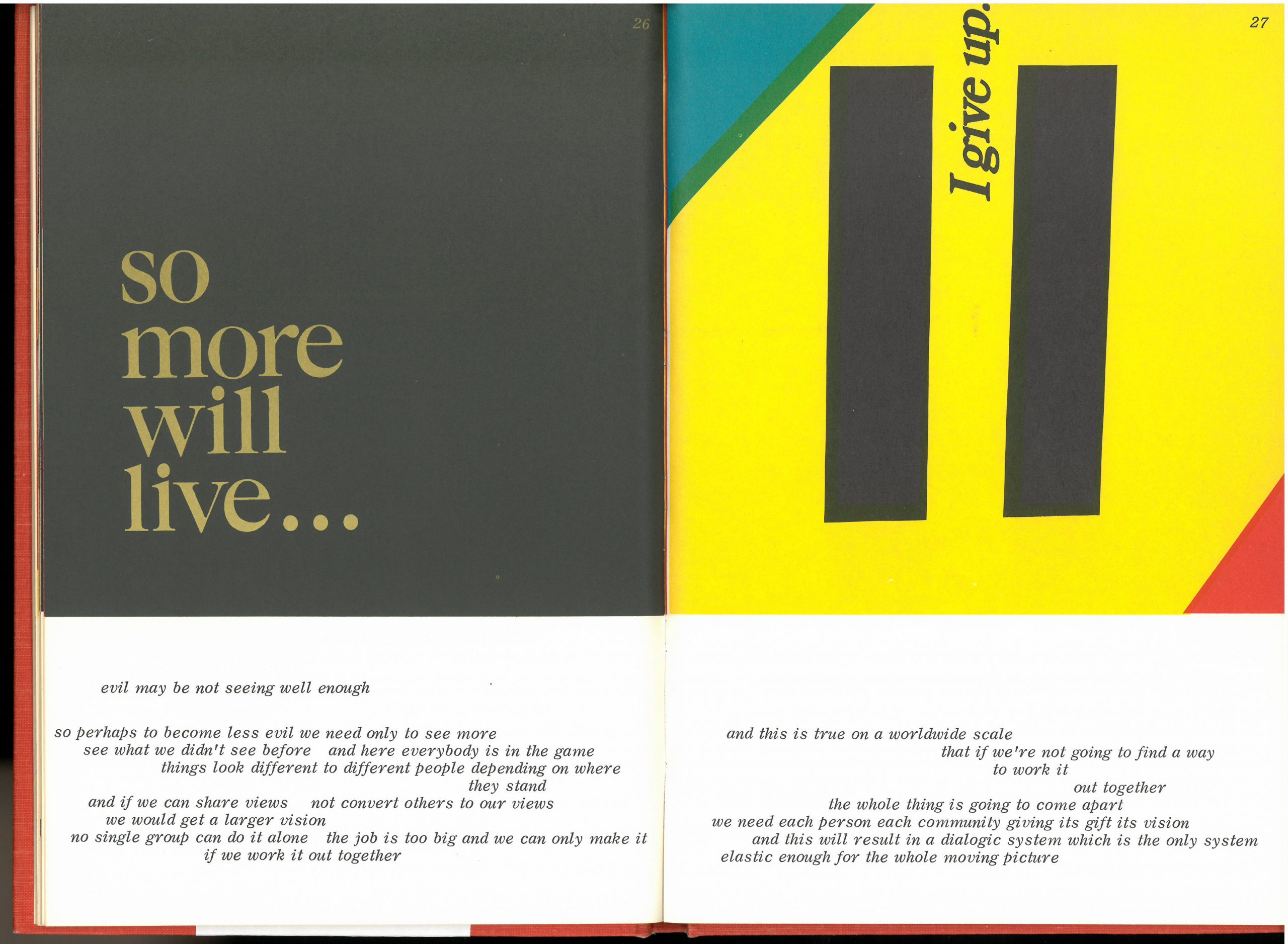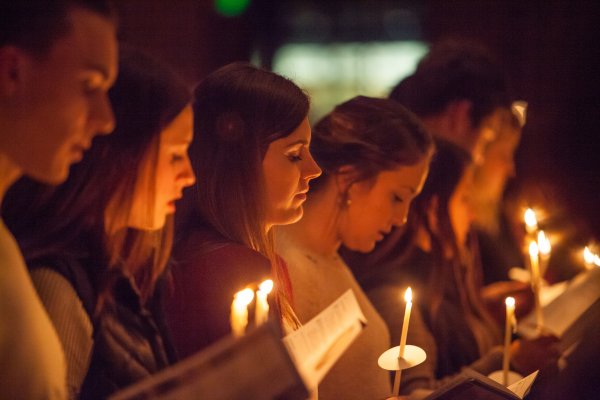This can’t be done alone
For now we see in a mirror, dimly, but then we will see face to face. Now I know only in part; then I will know fully, even as I have been fully known. (1 Corinthians 13:12 NRSV)

In 1967, one year before she left the convent that had become too hectic a place for her to take up a quieter life of making art full time, the American artist Sister Corita Kent published a book, Footnotes and Headlines: a play-pray book. The book is an interaction between the typographic poster art of the ordinary, for which she’d become famous, and a playful prayer-poem that runs its length.
Pages 26 & 27 present the image above under which is the following:
evil may be not seeing well enough
so perhaps to become less evil we need only to see more
see what we didn’t see before and here everybody is in the game
things look different to different people depending on where
they stand
and if we can share views not convert other to our views
we would get a larger vision
no single group can do it alone the job is too big and we can only make it
if we work it out together
and this is true on a worldwide scale
that if we’re not going to find a way
to work it
out together
the whole thing is going to come apart
we need each person each community giving its gift its vision
and this will result in a dialogic system which is the only system
elastic enough for the whole moving picture
Excerpt From Footnotes and Headlines by Sister Corita Kent, (Herder and Herder) 1967
The entire book is charming for its earnest playfulness and gravely hopeful tone. These two pages, however, especially leapt out at me because, for several years now, I’ve had Paul’s words about “seeing in a mirror, dimly” lodged in my mind.
Here at Valpo, I’d picked up this familiar phrase as a call to the sort of intellectual humility necessary to navigate an ideologically pluralistic environment. I can’t claim to have everything exactly right, but then, neither can you. This fact obliges us to hold our positions loosely and allow that we might have overlooked something. It also risks a kind of relativism. If neither of us can have it exactly right, who can? Who’s to judge? We’re left, this side of eternity, with our growing list of questions to be resolved on that great day when we “see face to face.”
This summer, I picked up a book that I’d intended to read for a while, Nick Sousanis’ Unflattening. I was attracted to it because it’s a graphic novel and I’d read somewhere that it was Sousanis’ Ph.D. dissertation. Who gets away with submitting a graphic novel as dissertation?
Unflattening is a treatise on the nature of thinking and knowing. Early on, Sousanis employs the metaphor of binocular vision to make an important point. Neither of our eyes sees the full truth. If we look at a distant object, like a light pole, and cover one eye and then the other, we’ll experience the pole moving from side to side. Sousanis’ question is, “Which eye is correct? Where’s the pole?” We need both eyes to have the most accurate perspective.
I find this a helpful and hopeful supplement to my initial reading of Paul. Each of us sees as in a mirror, dimly, all of us need to hold our positions loosely. They are necessarily incomplete, yet, when we meet, it’s not merely mutual toleration of one another’s incomplete knowledge, our conversation has the potential to fill things out to a fuller perspective. Not perfect, but fuller. We’ll not get it absolutely right, but our conversation will go a long way to polishing the mirror.
Finding Corita’s poetic prayer adds to my wonder.
One day we will know fully, even as we are now, by our creator, fully known – known and yet beloved.
Pr. Jim
Sept. 30, 2020
Pastor Jim and Deaconess Kristin take turns writing weekly devotions for the Chapel of the Resurrection.
Image credit: From Footnotes and Headlines by Sister Corita Kent, (Herder and Herder) 1967
- Archives of Devotional Writings from our Pastoral Staff
- “HELP!”
- “Some Lent!”
- (Your vocation here) of people
- A call to courage for 2021
- A charming tale for over-achievers
- A Lesson On Beans … and Being
- A New Place
- A Point of Privilege
- A season of anticipation
- A Time of Dust
- Acquiring a peaceful spirit
- Advent = Hope
- All will be well
- Anastasis: the Greatest Story of God’s Saving Power
- Another kind of darkness
- Are we willing to cross the road for one another?
- As if we needed a reminder
- Beacons of hope
- Better Together
- Blessings As You Go
- Borderlands
- Can we learn to be happy?
- Carrying the COVID Cross
- Come and See
- Did Jesus really suffer?
- Doing without in a life of plenty
- Don’t miss this moment
- Exiles with Vision
- Fear not!
- Fear of the Lord
- Feeling at Home
- Finding Purpose in the Journey
- Finding Words for Times Like These
- Forgiving others – and ourselves
- Getting ahead with Jesus
- Getting down on Jesus’ level
- Getting through this together
- God is not overwhelmed
- Good Friday
- Grief & Graduation
- Have yourself a merry little Christmas — somehow
- Holy Week and Taking Out the Trash
- Holy Week: The aid station late in the semester
- Hopes & Dreams vs Life in the Wilderness
- How do you keep from giving up hope?
- How glad we’ll be if it’s so
- I almost slipped
- Imagining Eternity
- In a time of uncertainty, these things are certain
- In everything, grateful
- In praise of plans B … C … D …
- In the midst of grief, God will bring life
- Is there such a thing as being too forgiving?
- It’s a Three Day Weekend!
- It’s In the Bag
- It’s What’s Happening
- Jesus among us
- Killing off our future selves
- Knowing a Good Thing When We See It
- Lessons in fire building
- Let there be light!
- Let us work for real wellness in our communities
- Life Is a Highway
- Lilies and leaves and whatever else is beautiful
- Living in the Present
- Naming our demons
- O Lord, you know I hate buttermilk
- Of Fear and Failure
- On Christian Unity: When we’re not one big happy church
- On the Bucket List
- On the day after the night before
- Overwhelmed
- Persistent and Extravagant
- Pray and Let God Worry
- Praying for Reconciliation
- Preparing for the world to be turned rightside up
- Recovering from an Epic Fail
- Reformation calls for examination
- Remembering among the forgetful
- Rest
- Rest is Holy
- Right where we are
- Seeing beauty in brokenness
- Signs of Love
- Starting Small
- Still in the storm
- Surprisingly Simple: Breathe!
- Taking a Break from the Relentless
- Talking ourselves into it
- Thankfulness leads to joyfulness
- The Art of Holy Week
- The Funny Business of Forgiveness
- The Greatest of These is Love
- The Magi: Exemplars of Faith and Learning
- The Power of Small Conversations
- The Trouble with Mammon
- The Power of Taking a Sabbath
- The Spiritual Gift of Hindsight
- This can’t be done alone
- To be known
- Too.Much.
- You might be a Lutheran if…
- You will be in our prayers this summer of 2020
- Ventures of which we cannot see the ending
- WWJD? We already know
- Walking in the Light of Jesus’ Resurrection
- We had hoped
- We’re on a mission from God
- What do you do with your anger?
- What good is a shepherd?
- What is your base reality?
- What to do after you find your voice
- What to do on the day after
- What we know and what we don’t know
- When bad things happen
- When God uses something terrible for good
- When heaven & earth click
- When joy and sadness live together
- When stress overwhelms
- When the promise of resurrection is hard to believe
- When you offer up your broken cup
- When we are moved
- Where God will be found
- Where is the good shepherd carrying you?
- Wilderness Journeys
- Won’t you be my neighbor?
- Year-end time management: Keeping the main thing the main thing
- Your Valpo roots will help you grow into your future
